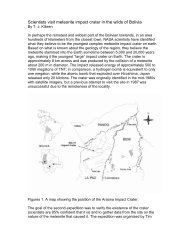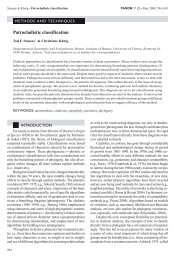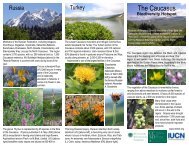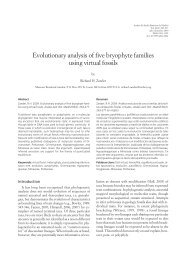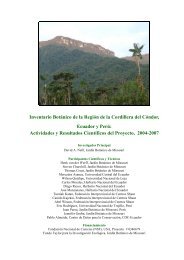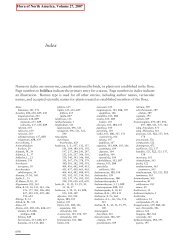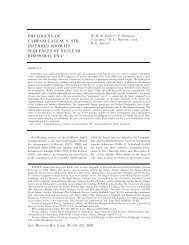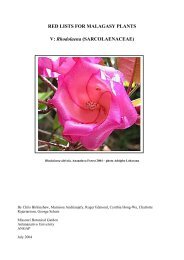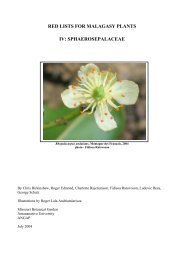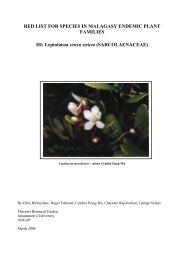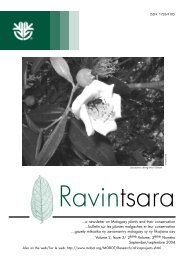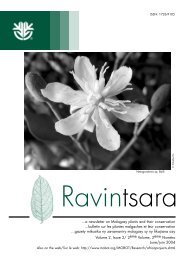re-evaluation of tortella - Missouri Botanical Garden
re-evaluation of tortella - Missouri Botanical Garden
re-evaluation of tortella - Missouri Botanical Garden
You also want an ePaper? Increase the reach of your titles
YUMPU automatically turns print PDFs into web optimized ePapers that Google loves.
in the lamina, the var. fragilifolia is usually broken at<br />
the leaf tip.<br />
Dixon (1924) was also not su<strong>re</strong> <strong>of</strong> the<br />
distinction <strong>of</strong> Tortella fragilis from T. tortuosa. He<br />
would have liked to have been definite but, "I have,<br />
however, <strong>re</strong>ceived specimens from two or th<strong>re</strong>e<br />
localities in Labrador showing a distinct approach to [T.<br />
tortuosa]; the leaves on some <strong>of</strong> the plants, and even the<br />
lower leaves on some stems in which the distal ones a<strong>re</strong><br />
quite typical, being strongly contorted when dry, crisped<br />
and undulate at the margin, and when moist slightly<br />
flexuose and undulate; hardly, indeed, to be <strong>re</strong>cognised<br />
from the var. fragilifolia...except by the leaves<br />
somewhat firmer, the very shining nerve and the<br />
p<strong>re</strong>sence (usually) <strong>of</strong> some rigid and less curved<br />
leaves." He speculated that T. fragilis would be found to<br />
be close to T. tortuosa "by intermediate forms."<br />
Polunin (1947), when <strong>re</strong>porting Tortella<br />
fragilis for the Canadian Eastern Arctic, quoted the<br />
same lines from Dixon (1924), adding "This puzzling<br />
situation that Mr. Dixon has so ably elucidated is to be<br />
found also in the specimens from Baffin Island"<br />
although some <strong>of</strong> these specimens, upon examination,<br />
may turn out to be T. tortuosa var. arctica.<br />
Tortella tortuosa var. fragilifolia in North<br />
America appears to be a montane and bo<strong>re</strong>al taxon. The<br />
var. fragilifolia in North America is appa<strong>re</strong>ntly not in<br />
montane elevations much south <strong>of</strong> the latitude <strong>of</strong> the<br />
Canadian border with the conterminous United States.<br />
TORTELLA NITIDA IN NORTH AMERICA<br />
Sources <strong>of</strong> North American <strong>re</strong>ports <strong>of</strong> Tortella nitida<br />
perhaps began with Renauld and Cardot (1889: 99) (as<br />
Trichostomum nitidum) "United States, without locality,<br />
collected by James, communicated by Mr. Besche<strong>re</strong>lle."<br />
Barnes (1897: 275–276) next <strong>re</strong>ported the<br />
species, quoting Renauld and Cardot and basing his<br />
description on Limpricht (1890, 1: 581) whe<strong>re</strong> the<br />
description <strong>of</strong> the proximal cells indicates their being<br />
"less sharply marked <strong>of</strong>f from chlorophyllose cells."<br />
Assuming James, <strong>of</strong> the Renauld and Cardot quote, to<br />
be Thomas Potts James (1803–1882), a <strong>re</strong>quest was<br />
made to the Farlow Herbarium for a specimen that<br />
might cor<strong>re</strong>spond, but without success. A James<br />
specimen at NY collected by him in Canada, July 1850,<br />
was Tortella tortuosa var. tortuosa.<br />
Next, the<strong>re</strong> is the exsiccat specimen in the<br />
Canadian Musci by John Macoun, number 605, labeled<br />
as Barbula nitida. In 1892, Macoun and N. C. Kindberg<br />
published the label data (number 196, p. 52). Kindberg<br />
(1897) affirmed its occur<strong>re</strong>nce ("Can.: Macoun.),<br />
p<strong>re</strong>sumably from Macoun's exsiccat number 605.<br />
Macoun 605 is labeled as Barbula nitidum [sic] (Lindb.)<br />
Jur., <strong>of</strong> the Canadian Musci series, "on wet earth at<br />
Hector, Rocky Mountains, B.C. [British Columbia,<br />
Canada], Aug. 14th, 1890" and is Tortella tortuosa var.<br />
fragilifolia (one specimen at FH, two others at NY). It is<br />
as tall as the typical variety gets, has a broad stem<br />
section but no central strand. Some apices a<strong>re</strong> deciduous<br />
and the<strong>re</strong> is conspicuous fragility <strong>of</strong> the lamina. The<br />
24<br />
crucial juxtacostal bistratose character <strong>of</strong> the leaf<br />
cross section is p<strong>re</strong>sent. The cells <strong>of</strong> the lamina a<strong>re</strong><br />
unusual for the species, on some leaves <strong>re</strong>gularly ca. 14<br />
µm, some even to 17 µm in diameter, with distal<br />
proximal cells thick-walled and porose. Some leaves on<br />
the same stem have adaxial quadrate cells covering the<br />
costa nearly to the apex, in others the adaxial surface <strong>of</strong><br />
the costa is exposed in a narrow groove from base to<br />
apex.<br />
Subsequent <strong>re</strong>ports <strong>of</strong> Tortella nitida include<br />
Haring's (1938) t<strong>re</strong>atment in Grout's moss flora <strong>of</strong> North<br />
America, Flower's t<strong>re</strong>atment for the state <strong>of</strong> Utah<br />
(1973), Ketchledge's publication on the moss flora <strong>of</strong><br />
New York State (1957), Stee<strong>re</strong> and Scotter's (1978)<br />
<strong>re</strong>port for the Nahanni P<strong>re</strong>serve, in the Mackenzie<br />
District <strong>of</strong> the Northwest Territories, and the <strong>re</strong>cent<br />
checklist <strong>of</strong> Canadian mosses (I<strong>re</strong>land et al. 1987).<br />
Haring (1938) cited Macoun's number 605 in<br />
the Canadian Musci as Tortella nitida; also a specimen<br />
from Montana in NY, and one by Homer House, a<br />
specimen from Harris Lake, New York. Haring and<br />
perhaps Grout, we<strong>re</strong> strongly influenced in their<br />
expectations by the Macoun specimen. This was at a<br />
time when it was not yet accepted that some <strong>of</strong> Macoun<br />
and Kindberg's determinations we<strong>re</strong> perhaps doubtful.<br />
Kindberg's determinations <strong>of</strong> Macoun's specimens<br />
"we<strong>re</strong> <strong>of</strong>ten hasty and consequently wrong and<br />
Macoun's own determinations we<strong>re</strong> <strong>of</strong>ten based on<br />
superficial study and thus a<strong>re</strong> open to doubt" (Sch<strong>of</strong>ield<br />
1965), and yet Besche<strong>re</strong>lle and Dixon also made similar<br />
independent determinations.<br />
Examination <strong>of</strong> the specimen <strong>of</strong> Tortella nitida<br />
that Haring cited for Lake Harris (New York, Essex Co.,<br />
Newcomb, surface <strong>of</strong> boulder on sho<strong>re</strong> (perichaetiate:<br />
without sporophytes), July 10, 1927, H.D.House (NYS),<br />
shows this specimen also to be Tortella tortuosa var.<br />
fragilifolia. The Harris Lake specimen was fragile in<br />
some stems, but on the whole seems mo<strong>re</strong> typical <strong>of</strong> T.<br />
tortuosa than most examples <strong>of</strong> the variety fragilifolia<br />
(it had no stem central strand). The leaves on some<br />
stems, however, we<strong>re</strong> mo<strong>re</strong> broadly lanceolate with<br />
larger distal laminal cells (to 12 µm). Some <strong>of</strong> the leaf<br />
cross sections showed some bistratose a<strong>re</strong>as near the<br />
costa in the distal median portion <strong>of</strong> the leaf.<br />
The Harris Lake specimen showed no<br />
annotation by Haring or Grout. The<strong>re</strong> was a query on<br />
the label, and the note, "Doubtful !E.H.K" [Edwin H.<br />
Ketchledge] written on the packet. Ketchledge's<br />
subsequent publication on the moss flora <strong>of</strong> New York<br />
State (1957) listed Tortella nitida for the New York<br />
flora, but in the <strong>re</strong>vised edition (Ketchledge 1980), the<strong>re</strong><br />
was no citation <strong>of</strong> that species.<br />
Another specimen <strong>of</strong> the var. fragilifolia, from<br />
New York on limestone pavement in Jefferson Co. in<br />
association with Tortella rigens, is cited below in the<br />
t<strong>re</strong>atment <strong>of</strong> that species.<br />
Haring's third <strong>re</strong>p<strong>re</strong>sentative specimen was<br />
from Montana at NY. A specimen from Montana<br />
collected by R. S. Williams, 329 at NY was determined<br />
he<strong>re</strong> to be Tortella alpicola (see discussion <strong>of</strong> this





